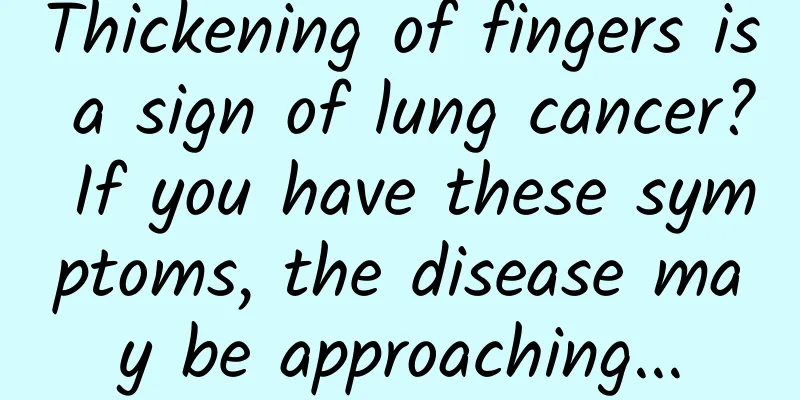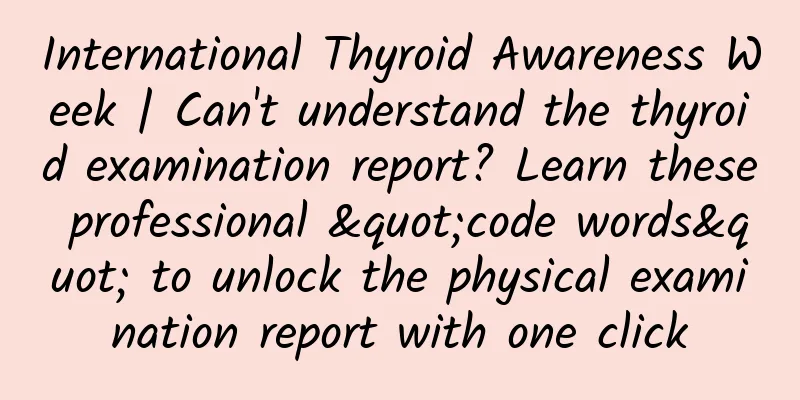Thickening of fingers is a sign of lung cancer? If you have these symptoms, the disease may be approaching...

|
Expert of this article: Wang Qian, attending physician, Department of Infectious Diseases, First Hospital of Hebei Medical University This article was reviewed by Li Jiangtao, Associate Chief Physician, Department of Respiratory and Critical Care Medicine, Hebei Chest Hospital Do you often pay attention to the changes in your hands? Most people may care about whether their fingers are slender and whether their nails are neat and clean... These do affect the beauty of our hands, but sometimes they also indicate the arrival of some diseases. Recently, a woman in Guangdong found some changes in her hands. Her fingers and toes became thicker and thicker, but because there were no other obvious symptoms, she did not pay much attention to it. By chance, she met a doctor, who suggested that she go to the hospital for a check-up as soon as possible. Weibo screenshot After medical examination, the woman was found to have a tumor of about 4 centimeters in her lung, and the doctor diagnosed it as lung cancer. Why is it that changes in the fingers are related to lung cancer? What is the problem with such swelling at the end of the fingers? Let's take a look at what is going on today. What is finger clubbing? The thickening of the fingertips is medically known as clubbing, which is defined as: the finger (toe) is enlarged and appears drumstick-shaped or the base angle between the proximal end of the nail and the soft tissue of the nail root is ≥180 degrees. In clinical practice, clubbing of fingers is more common than that of toes. Finger clubbing is a metabolic disorder caused by chronic hypoxia and long-term anoxia in the body. Hypoxia causes the capillaries of the distal limbs to dilate. Due to the abundant blood flow at the distal end, painless proliferation of soft tissue is obvious, eventually forming acromegaly and the distal knuckles become thicker and swollen, which is called finger clubbing. Why do people with lung cancer develop finger clubbing? For patients with lung cancer, the tumor compresses the airway and blood vessels, and the body is in a state of chronic hypoxia. If not treated for a long time, clubbing of the fingers may occur. What diseases might clubbing indicate? There are many reasons that can lead to clubbing of fingers. 75-80% are caused by lung diseases, 10-15% are caused by cardiovascular diseases, and other diseases and genetics also account for a certain proportion. The most common clinical clubbing that should be vigilant is mainly the following: Copyright image, no permission to reprint If finger clubbing occurs in middle-aged or older people, or if there is a history of long-term heavy smoking, or if there is a history of lung cancer in the immediate family, and if there is chest pain, hemoptysis, or coughing due to unknown causes, you should be highly alert to lung cancer and should seek medical attention from the respiratory department or thoracic surgery department in a timely manner. If accompanied by long-term chronic cough, spitting up a lot of purulent sputum, repeated hemoptysis or blood in sputum, be alert to lung infectious diseases such as bronchiectasis, lung abscess, etc., it is recommended to see a respiratory department; If the clubbing occurs at an early age, accompanied by cyanosis of the lips and hypoxia, and squatting phenomenon (a forced posture in which the child bends his legs and squats for a while while walking or playing, and then resumes normal walking), it is considered that there may be congenital heart disease, and cardiology and cardiac surgery should be consulted; If accompanied by long-term intermittent fever, splenomegaly, skin hemorrhages, and embolism in the limbs, be alert to infective endocarditis, which is a very serious infection and requires immediate cardiology hospitalization; Clubbing is relatively rare in digestive system diseases, but when it is combined with viral hepatitis or long-term heavy drinking, ascites, varicose veins in the abdomen, and jaundice of the body, one should be alert to cirrhosis. How to self-diagnose whether you have finger clubbing? Since finger clubbing has so many implications for us, how do we check ourselves to see if we have finger clubbing? The first method: Place the backs of the middle fingers of both hands together, and bring the end finger joints and fingers together. If there is a small diamond-shaped gap between the bases of the two fingers, it is normal; if the gap becomes smaller or disappears, it may be clubbing. If accompanied by the above discomfort, you need to see a doctor in time. The second method: the superior angle measurement method. On the front of the finger, there is a base angle between the nail surface and the skin at the end. For normal people, this angle is less than 160 degrees, but for clubbed fingers, this angle is often greater than 180 degrees. What should I do if I notice finger clubbing? First of all, we need to clarify a concept: the presence of clubbing does not mean that the disease has been diagnosed. Clubbing itself is relatively common. Many people have clubbing, and they do not feel uncomfortable. Complete examinations have not found any related diseases. In this case, we do not need to worry too much. The appearance of clubbing may indicate some diseases, and examinations are necessary when necessary. Copyright image, no permission to reprint In clinical practice, the treatment of clubbing is still based on the primary disease. When you find yourself with clubbing, you need to consider whether you have other physical discomforts, such as coughing, spitting, hemoptysis, chest tightness, chest pain, etc. in the respiratory system, whether you have precordial pain in the heart, whether you have bleeding spots in the body, and other common discomfort symptoms mentioned above. Go to the relevant department for treatment, complete the necessary examinations, and carry out corresponding treatment according to the cause. Do not do too much treatment for the clubbed fingers themselves. The watermarked images and cover images in this article are from the copyright gallery, and the image content is not authorized for reprinting |
Recommend
What are the differences between Cistanche deserticola and Cistanche wine?
Cistanche deserticola is not only a very precious...
The efficacy and function of alfalfa root
Alfalfa root is rich in nutritional value and has...
Is it ok to eat a whole duck that costs 10 yuan on the roadside?
This article was reviewed by Pa Li Ze, chief phys...
Was there air pollution in ancient times? Let’s see what the ancients said!
Copywriter: Tianlan Editorial Office Edited by: R...
Why do you always feel that you are not good-looking?
This article was reviewed by Zhao Wei, MD, associ...
Effects and functions of fried white peony root
White peony root is a commonly used Chinese herba...
The efficacy and function of stone wind
There are so many medicinal herbs in the world, a...
The efficacy and function of leek lotus
Leek and lotus are something that many people are...
Success! my country has made a new breakthrough! It will benefit the world!
In the early morning of July 22, Beijing time, th...
What are the effects and functions of processed Shouwu
At present, more and more people are entering a s...
No one is better than this cat at slacking off!
The short Spring Festival holiday passed by like ...
The efficacy and function of the southern crane lice
Southern crane lice is a very familiar medicinal ...
The cleaner these 5 parts of your body are, the longer you may live!
45 years old is also called pre-senile The earlie...
What are the taboos of Clematis
Clematis is a common Chinese medicinal material, ...









